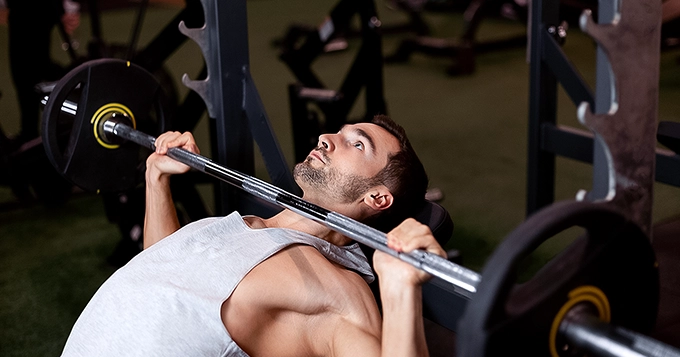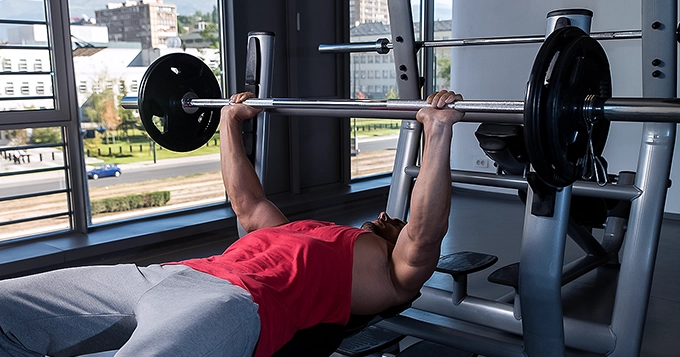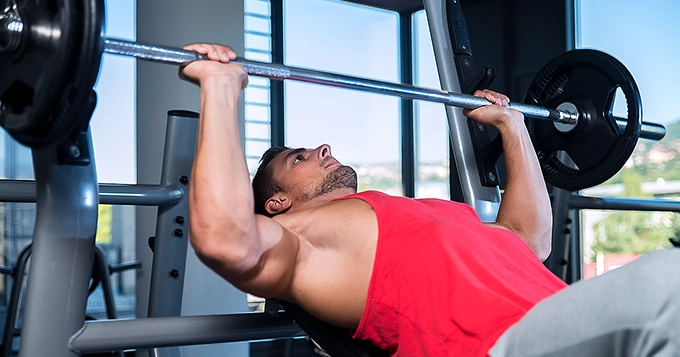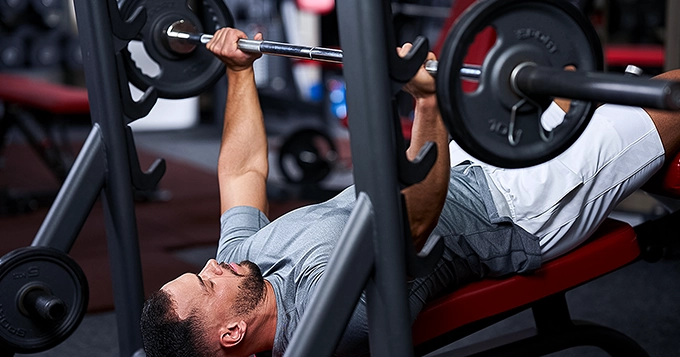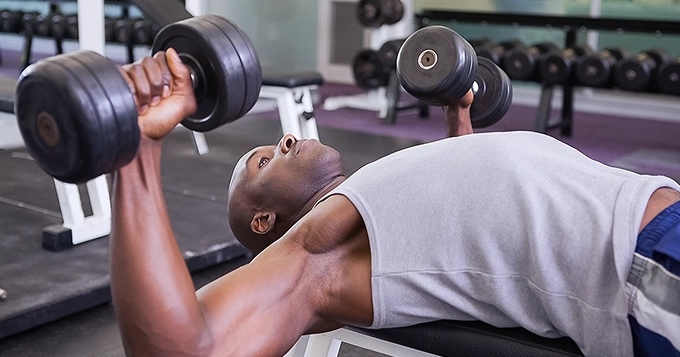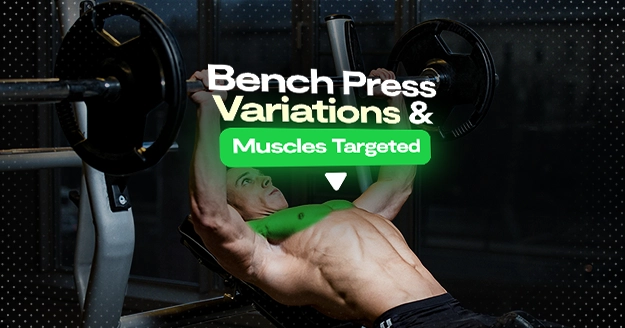The bench press exercise is a fundamental exercise in any strength training routine, known for its ability to target multiple muscle groups in the upper body.
Bench press benefits include:
- increased upper body strength
- muscle growth
- improved pushing power
- muscle balance
- functional strength
- metabolic boost
- bone health
- athletic performance
- confidence boost, and
- better mental health.
However, there are various bench press variations, each with its own unique benefits and muscle targets.
Exploring different types of bench press variations allows you to diversify your workouts and target specific muscle groups that you want to develop.
What muscles are worked in bench-press?
While the specific variation of bench presses may influence the targeted muscles to some extent, they primarily engage the following muscle groups:
- Pectoralis major
- Anterior deltoid
- Triceps brachii
- Biceps brachii
- Serratus anterior
Understanding the bench press muscles worked is essential for maximizing the effectiveness of your upper body workouts and achieving balanced strength development.
Keep reading to discover the most effective bench press variations for targeting specific muscles and learn the proper techniques for performing them.
1. Traditional Bench Press
The traditional or standard bench press is performed on a flat bench with a barbell. The bench press muscles worked primarily include the following muscle groups:
- Pectoralis Major: The primary muscle worked during the traditional bench press is the pecs major, which is responsible for the horizontal adduction of the arms.
- Anterior Deltoids: These are located on the front of the shoulders, the anterior deltoids assist in shoulder flexion and contribute to pressing movements.
- Triceps Brachii: These muscles are situated on the back of the upper arm. Your triceps assist in extending your elbow joint during the bench press.
How to Perform Traditional Bench Press
Step 1: Lie on a bench with your feet planted firmly on the ground.
Step 2: Grasp the barbell with a grip slightly wider than shoulder-width, ensuring your hands are directly aligned over your elbows.
Step 3: Lower the barbell towards your chest with control, keeping your elbows tucked close to your body.
Step 4: Pause briefly when the barbell touches your chest, then press it back up, fully extending your arms.
Step 5: Repeat based on your trainer’s recommendation or your desired number of repetitions.
2. Incline Bench Press
In the incline bench press workout, the bench is set at an inclined angle (usually around 30-45 degrees). This variation primarily targets:
- Upper Pectoralis Major: The incline angle places more emphasis on the upper portion of your chest, helping to develop a well-rounded chest shape.
- Anterior Deltoids: Similar to the standard bench press, the incline bench press also engages the anterior deltoids to a significant extent.
- Triceps Brachii: The triceps continue to play a supporting role in elbow extension during the incline bench press.
How to Perform Incline Bench Press
Step 1: Set the bench at a 30 to 45 degree incline.
Step 2: Lie on the bench with your feet flat on the floor, then grip the barbell slightly wider than shoulder-width apart.
Step 3: Lower the barbell to your upper chest, maintaining control throughout the movement.
Step 4: Press the barbell back up to the starting position, fully extending your arms.
Step 5: Repeat based on your trainer’s recommendation or your desired number of repetitions.
3. Decline Bench Press
Conversely, the decline bench press is performed with the bench set at a decline angle (usually around 15-30 degrees). This variation primarily targets:
- Lower Pectoralis Major: The decline angle shifts the emphasis to the lower portion of the chest, helping to develop thickness and definition in this area.
- Triceps Brachii: As with the other bench press variations, the triceps are still actively engaged in extending the elbow joint.
- Shoulder Stability Muscles: Due to the decline angle, additional stabilizer muscles around the shoulders and upper back may be activated to maintain proper form.
How to Perform Decline Bench Press
Step 1: Set the bench at a 15 to 30 degree decline.
Step 2: Lie on the bench with your feet secured under the footpads and grip the barbell slightly wider than shoulder-width apart.
Step 3: Lower the barbell to your lower chest, keeping your elbows tucked close to your body.
Step 4: Press the barbell back up to the starting position, fully extending your arms.
Step 5: Repeat based on your trainer’s recommendation or your desired number of repetitions.
4. Close-Grip Bench Press
In the close-grip bench press, the hands are positioned closer together on the barbell, typically shoulder-width apart or narrower. This variation primarily targets:
- Triceps Brachii: With the hands positioned closer together, the triceps are under greater tension throughout the movement, making this variation highly effective for triceps development.
- Pectoralis Major: While the emphasis shifts slightly away from the chest, the close-grip bench press still engages the pectoralis major to a significant extent.
- Anterior Deltoids: The anterior deltoids are also engaged to stabilize the shoulders during the movement.
How to Perform Close-Grip Bench Press
Step 1: Lie flat on a bench with your feet planted firmly on the ground.
Step 2: Grip the barbell with your hands positioned shoulder-width apart or closer.
Step 3: Lower the barbell towards your lower chest while keeping your elbows close to your body.
Step 4: Press the barbell back up to the starting position, fully extending your arms.
Step 5: Repeat based on your trainer’s recommendation or your desired number of repetitions.
5. Dumbbell Bench Press
The dumbbell bench press involves using dumbbells instead of a barbell, allowing for a greater range of motion and unilateral strength development. This variation targets:
- Pectoralis Major: Like the standard bench press, the dumbbell bench press primarily targets the chest muscles.
- Stabilizer Muscles: Using dumbbells requires greater stabilization from the muscles around the shoulders and upper back, making this variation beneficial for overall shoulder health and stability.
- Triceps Brachii: The triceps are still engaged in extending the elbows during the dumbbell bench press, though to a slightly lesser extent compared to the barbell variations.
How to Perform Dumbbell Bench Press
Step 1: Sit on a flat bench. Hold a dumbbell in both hands, resting on your thighs.
Step 2: Lie back on the bench and lift the dumbbells until they reach shoulder height, your palms facing forward.
Step 3: Lower the dumbbells towards your chest, keeping your elbows at a 45-degree angle.
Step 4: Press the dumbbells back up to the starting position, fully extending your arms.
Step 5: Repeat based on your trainer’s recommendation or your desired number of repetitions.
General Tips When Doing Bench Press
- Maintain Proper Form
Keep your back flat against the bench, feet firmly planted on the ground, and elbows tucked close to your body throughout the movement.
- Use a Spotter
When you’re lifting heavy weights, it’s best to always have a spotter who can assist you and ensure your safety.
- Control the Weight
Lower the weight under control, avoiding bouncing the bar off your chest.
- Breathe Properly
Inhale as you lower the weight and exhale while you press it back up.
- Start with Light Weights
If you’re new to bench pressing or trying a new variation, start with lighter weights to practice proper form and technique before progressing to heavier loads.
